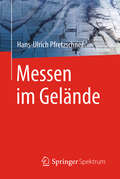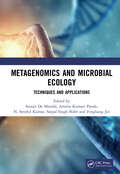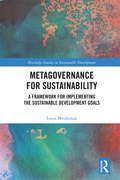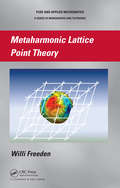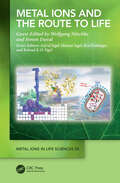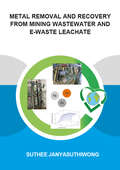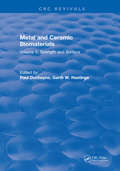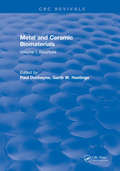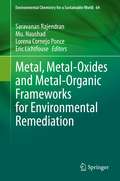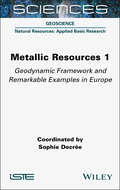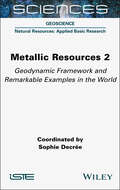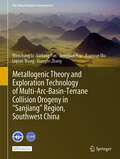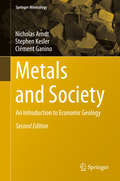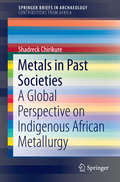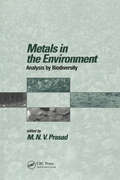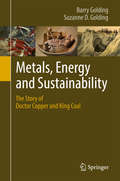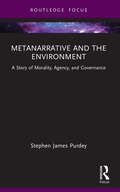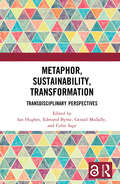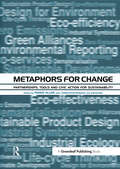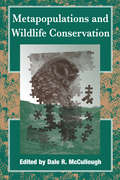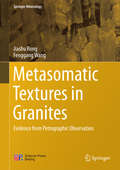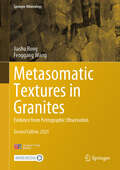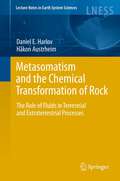- Table View
- List View
Messen im Gelände
by Hans-Ulrich PfretzschnerDer vorliegende Leitfaden erläutert Studierenden der Geowissenschaften die grundlegenden Techniken der Aufnahme geodätischer Daten, die Umsetzung solcher Daten in topographische Karten und Höhenprofile, aber auch die grundlegenden geologischen Messtechniken und die Erstellung geologischer Profile. Sowohl einfache "Freihandtechniken", die auch von einer Person beim Prospektieren angewendet werden können, wie auch der Einsatz professioneller Präzisionsinstrumente finden Eingang in dieses Buch. Im ersten Abschnitt werden Kartenkoordinatensysteme und der Umgang mit Kartenkoordinaten vorgestellt. Es schließt sich im zweiten Teil eine detaillierte Darstellung der für die Geowissenschaftlerin bzw. den Geowissenschaftler wichtigen geodätischen wie auch geologischen Messtechniken an sowie eine kurze Einführung in die Erstellung geologischer Profile. Das Lehrbuch schließt ab mit einer Instrumentenkunde, in welcher die bei den Messungen eingesetzten Instrumente vorgestellt werden.
Meta-attributes and Artificial Networking: A New Tool for Seismic Interpretation (Special Publications #76)
by Kalachand Sain Priyadarshi Chinmoy KumarMeta-Attributes and Artificial Networking Meta-Attributes and Artificial Networking A New Tool for Seismic Interpretation Seismic data gathered on the surface can be used to generate numerous seismic attributes that enable better understanding of subsurface geological structures and stratigraphic features. With an ever-increasing volume of seismic data available, machine learning augments faster data processing and interpretation of complex subsurface geology. Meta-Attributes and Artificial Networking: A New Tool for Seismic Interpretation explores how artificial neural networks can be used for the automatic interpretation of 2D and 3D seismic data. Volume highlights include: Historic evolution of seismic attributes Overview of meta-attributes and how to design them Workflows for the computation of meta-attributes from seismic data Case studies demonstrating the application of meta-attributes Sets of exercises with solutions provided Sample data sets available for hands-on exercises The American Geophysical Union promotes discovery in Earth and space science for the benefit of humanity. Its publications disseminate scientific knowledge and provide resources for researchers, students, and professionals.
Metagenomics and Microbial Ecology: Techniques and Applications
by Nachimuthu Senthil Kumar Surajit De Mandal Amrita Kumari Panda Satpal Singh Bisht Fengliang JinMicroorganisms comprise the greatest genetic diversity in the natural ecosystem, and characterization of these microbes is an essential step towards discovering novel products or understanding complex biological mechanisms. The advancement of metagenomics coupled with the introduction of high-throughput, cost-effective NGS technology has expanded the possibilities of microbial research in various biological systems. In addition to traditional culture and biochemical characteristics, omics approaches (metagenomics, metaproteomics, and metatranscriptomics) are useful for analyzing complete microbial communities and their functional attributes in various environments. Metagenomics and Microbial Ecology: Techniques and Applications explores the most recent advances in metagenomics research in the landscape of next-generation sequencing technologies. This book also describes how advances in sequencing technologies are used to study invisible microbes as well as the relationships between microorganisms in their respective environments. Features: Covers a wide range of concepts, investigations, and technological advancement in metagenomics at the global level. Highlights the novel and recent approaches to analyze microbial diversity and its functional attributes. Features a range of chapters that present an introduction to the field and functional insight into various ecosystems.
Metagovernance for Sustainability: A Framework for Implementing the Sustainable Development Goals (Routledge Studies in Sustainable Development)
by Louis MeulemanThe 17 Sustainable Development Goals (SDGs) which were adopted by the United Nations in September 2015 are universally applicable in all 193 UN Member States and connect the big challenges of our time, such as hunger and poverty, climate change, health in an urbanised environment, sustainable energy, mobility, economic development and environmental degradation. Sustainability has the characteristics of a ‘wicked problem’, for which there are no one-size-fits-all solutions. This book tests the hypothesis that the implementation of sustainable development, and in particular the 2015 SDGs, requires tailor-made metagovernance or ‘governance of governance’. This is necessary to develop effective governance and high quality and inclusive public administration and to foster policy and institutional coherence to support implementing the SDGs. Based on the growing literature on governance and metagovernance, and taking into account the specificities of societal factors such as different values and traditions in different countries, the book presents a framework for the design and management of SDG implementation. It shows how hierarchical, network and market governance styles can be combined and how governance failure can be prevented or dealt with. The book presents an overview of fifty ‘shades of governance’ which differ for each governance style, and a sketch of a concrete method to apply sustainability metagovernance. Metagovernance for Sustainability is relevant to academic and practitioner fields across many disciplines and problem areas. It will be of particular interest to scholars, students and policy-makers studying Sustainable Development, Governance and Metagovernance, Public Management and Capacity Building.
Metaharmonic Lattice Point Theory (Chapman & Hall Pure and Applied Mathematics)
by Willi FreedenMetaharmonic Lattice Point Theory covers interrelated methods and tools of spherically oriented geomathematics and periodically reflected analytic number theory. The book establishes multi-dimensional Euler and Poisson summation formulas corresponding to elliptic operators for the adaptive determination and calculation of formulas and identities of
Metal Ions and the Route to Life (Metal Ions in Life Sciences Series)
by Wolfgang NitschkeVolume 28, entitled Metal Ions and the Route to Life, of the series Metal Ions in Life Sciences, advocates for the prime importance of the recognition of metal ions and metal-bearing minerals in the transition from inanimate matter to first life on our planet. Unlike the relatively unreactive organic molecules, the traditional protagonists of orthodox origin-of-life hypotheses, metals and minerals are natural catalysts, abundantly present in the majority of settings on the early Earth considered as conducive to bringing forth life. In these palaeogeochemical settings, they may have catalyzed the anabolic conversions of inorganic precursor molecules into organics and may have converted redox disequilibria between environmental reductants and oxidants into the ordering, i.e. the lowering of entropy, of first living entities. Far-fetched? Yet, this is precisely what metal ions do in life today! An unlikely coalition of biology (biochemistry and bioenergetics) and physics (thermodynamics and condensed matter physics) is growingly questioning the plausibility of the orthodox hypotheses while putting metal ions and minerals centre-stage in their scenarios. In this volume, 29 internationally renowned experts from fields as diverse as microbiology, biochemistry, astrobiology, electrochemistry, ecology, mineralogy, geology and geochemistry shine light from their individual angles on this topic, bringing home metal ions’ primordial importance to extant life, presenting minerals with tantalizing reactivities appearing as look-alikes of life’s processes and sketching out plausible, metal-ion-based scenarios for life’s emergence on planet Earth. Metal Ions and the Route to Life provides the empirical groundwork to interested researchers and the general public for revisiting their preconceived ideas about the origin of life and for appreciating the absolute indispensability of metal ions in life – now just as at its beginnings!
Metal Removal and Recovery from Mining Wastewater and E-waste Leachate (IHE Delft PhD Thesis Series)
by Suthee JanyasuthiwongMetal contamination in the environment is a persisting global issue. The metal reservoirs in the earth have declined due to society’s needs and due to uncontrolled mining activities. Therefore, the idea to recover metals from waste streams has emerged. In this thesis, cost competitive technologies such as adsorption using agro-wastes and precipitation using an inverse fluidized bed (IFB) reactor were investigated, with special emphasis on the recovery of base metals. Groundnut shell showed good potential for metal (Cu, Pb and Zn) removal. From artificial neural network modeling, the performance of the sulfate reducing bacteria (SRB) was found to be strongly pH dependent; the removal efficiency of Cu and Zn in the IFB at pH 5.0 was >97%. Electronic waste is a good candidate as secondary metal resource. The recovery of Cu from computer printed circuited boards (PCBs) using biogenic sulfide precipitation was investigated as well. Using this technology, Cu could be recovered at ~0.48 g Cu/g PCBs.
Metal and Ceramic Biomaterials: Volume I: Structure
by DucheyneThe understanding of the in vivo performance of synthetic materials is largely dependent upon a profound knowledge of the properties of the materials in question. Analogous to materials science in its broadest sense, the basis for biomaterials science is formed by microstructural there. It is therefore, that in this series on structure property relationships in biomaterials a substantial part is devoted to the analysis of the basic properties of the various synthetic biomaterials. In addition, the effect of microstructural aspects on properties is considered at great length.
Metal and Ceramic Biomaterials: Volume II: Strength and Surface
by DucheyneThe understanding of the in vivo performance of synthetic materials is largely dependent upon a profound knowledge of the properties of the materials in question. Analogous to materials science in its broadest sense, the basis for biomaterials science is formed by microstructural there. It is therefore, that in this series on structure property relationships in biomaterials a substantial part is devoted to the analysis of the basic properties of the various synthetic biomaterials. In addition, the effect of microstructural aspects on properties is considered at great length.
Metal, Metal-Oxides and Metal-Organic Frameworks for Environmental Remediation (Environmental Chemistry for a Sustainable World #64)
by Eric Lichtfouse Mu. Naushad Saravanan Rajendran Lorena Cornejo PonceThis book reviews principles, techniques and applications of metal, metal oxides, metal sulfides and metal-organic frameworks for removal and degradation of pollutants. Natural materials are often much more advanced than synthetic materials in terms of circularity and are functional, often biodegradable, recyclable and generate little waste. They are, therefore, a source of inspiration for new synthetic materials. In particular, recent research has focused on various types of functional materials such as organic, inorganic, nanostructured and composites for the remediation of environmental pollution.
Metallic Resources 1: Geodynamic Framework and Remarkable Examples in Europe
by Sophie DecréeMetallic resources play a huge role in many fields: in the energy transition, the development of new technologies and the production and storage of green energy. Metallic Resources 1 presents various studies in notable European metallogenic regions or deposits that enable us to tackle the question of the concentration of metals, especially strategic metals, in various geodynamic settings. An understanding of the geological processes that lead to the formation of deposits and influence their concentrations in the Earth's crust is of the utmost importance when it comes to uncovering new mineral resources. This book puts forward various different methodological approaches necessary in the study of deposits of metallic resources, from field observations to microanalysis. A study of specific geo-politico-economic frameworks is also presented.
Metallic Resources 2: Geodynamic Framework and Remarkable Examples in the World
by Sophie DecréeMetallic resources play a huge role in many fields: in the energy transition, the development of new technologies and the production and storage of green energy. Metallic Resources 2 presents various studies in notable metallogenic regions or deposits worldwide that enable us to tackle the question of the concentration of metals, especially strategic metals, in various geodynamic settings. An understanding of the geological processes that lead to the formation of deposits and influence their concentrations in the Earth's crust is of the utmost importance when it comes to uncovering new mineral resources. This book puts forward various different methodological approaches necessary in the study of deposits of metallic resources, from field observations to microanalysis. A study of specific geo-politico-economic frameworks is also presented.
Metallogenic Theory and Exploration Technology of Multi-Arc-Basin-Terrane Collision Orogeny in “Sanjiang” Region, Southwest China (The China Geological Survey Series)
by Wenchang Li Guitang Pan Zengqian Hou Xuanxue Mo Liquan Wang Xiangfei ZhangThis open access book presents a new structural model of “multi-arc-basin-terrane system” based on the in-depth research of the Nujiang-Lancangjiang-Jinshajiang region, especially several Paleo-Tethys ophiolitic mélange belts and sets of arc-basin systems, and a new orogenic model of “The Hengduan shan Mountains” based on penetrated research on spatial-temporal framework and orogenic models of different orogenic belts under large-scale strike-slip-shear-nappe structures evolution. The authors paid special attention on the coupling relation between orogeny and metallogenesis. The metallogenesis and dynamic process are probed under the crust–mantle interaction and material-energy exchange-transmission background and the tectonic units evolution. The ore genesis and distribution of deposits have been thoroughly analyzed, and the metallogenic theories of "multi-arc-basin-terrane" and "intracontinental tectonic transformation" in the Nujiang-Lancangjiang-Jinshajiang region have been carried out. This book also illustrates how to explore metallic deposits in the Nujiang-Lancangjiang-Jinshajiang region by using the metallogenic regulations. Meanwhile, this book has high reference value for researchers working in the fields of basic geology, environmental geology, and energy geology.
Metals and Society
by Nicholas Arndt Clément GaninoIn the second edition Steve Kesler (University of Michigan) has been added as an author to rewrite some chapters. The motivation for this revised edition is to more intensively address economic issues that surround the exploitation of mineral resources. This emphasis gives the book a unique character. With these sections Metals and Society deals with issues that pervade much of current science reporting - the rate of exploitation of natural resources, the question of when or if these resources will be exhausted, the pollution and social disturbance that accompanies mining, the compromises and challenges that arise from the explosion of demand from China, India and other rapidly developing countries, and the moral issues that surround mining of metals in lesser developed countries for consumption in the "first-world" countries. With its dual character, the book will be useful as an introductory text for students in the earth sciences and a reference volume for students, teachers and researchers of geography, economics and the social sciences.
Metals and Society
by Nicholas Arndt Clément Ganino Stephen KeslerThis book is a comprehensive overview of economic geology for the general geologist and anyone else interested in the minerals industry and the global supply of raw materials. It includes some thought-provoking statements and questions for discussion on globalisation and current practices in the minerals industry. In the second edition, all chapters have been extensively revised, and a new author has been added to increase coverage of some mineral deposits and topics. The economic issues surrounding the exploitation of mineral resources is discussed in three of the six chapters of the book. It deals with issues that are commonly addressed in current science reporting - the rate of exploitation of natural resources, the question of when or if these resources will be exhausted, the pollution and social disturbance that accompanies mining, the compromises and challenges that arise from the explosion in demand from China, India and other rapidly developing countries, and the moral issues that surround mining of metals in lesser-developed countries for consumption in the "first-world" countries. The book will be useful both as an introductory text for students in the earth sciences and a reference volume for students, teachers and researchers of geography, economics and the social sciences.
Metals in Past Societies
by Shadreck ChirikureThis book seeks to communicate to both a global and local audience, the key attributes of pre-industrial African metallurgy such as technological variation across space and time, methods of mining and extractive metallurgy and the fabrication of metal objects. These processes were transformative in a physical and metaphoric sense, which made them total social facts. Because the production and use of metals was an accretion of various categories of practice, a chaine operatoire conceptual and theoretical framework that simultaneously considers the embedded technological and anthropological factors was used. The book focuses on Africa's different regions as roughly defined by cultural geography. On the one hand there is North Africa, Egypt, the Egyptian Sudan, and the Horn of Africa which share cultural inheritances with the Middle East and on the other is Africa south of the Sahara and the Sudan which despite interacting with the former is remarkably different in terms of technological practice. For example, not only is the timing of metallurgy different but so is the infrastructure for working metals and the associated symbolic and sociological factors. The cultural valuation of metals and the social positions of metal workers were different too although there is evidence of some values transfer and multi-directional technological cross borrowing. The multitude of permutations associated with metals production and use amply demonstrates that metals participated in the production and reproduction of society. Despite huge temporal and spatial differences there are so many common factors between African metallurgy and that of other regions of the world. For example, the role of magic and ritual in metal working is almost universal be it in Bolivia, Nepal, Malawi, Timna, Togo or Zimbabwe. Similarly, techniques of mining were constrained by the underlying geology but this should not in any way suggest that Africa's metallurgy was derivative or that the continent had no initiative. Rather it demonstrates that when confronted with similar challenges, humanity in different regions of the world responded to identical challenges in predictable ways mediated as mediated by the prevailing cultural context. The success of the use of historical and ethnographic data in understanding variation and improvisation in African metallurgical practices flags the potential utility of these sources in Asia, Latin America and Europe. Some nuance is however needed because it is simply naïve to assume that everything depicted in the history or ethnography has a parallel in the past and vice versa. Rather, the confluence of archaeology, history and ethnography becomes a pedestal for dialogue between different sources, subjects and ideas that is important for broadening our knowledge of global categories of metallurgical practice.
Metals in the Environment: Analysis by Biodiversity (Books in Soils, Plants, and the Environment)
by M.N.V. PrasadA summary of data on heavy metal accumulation, biomonitoring, toxicity and tolerance, metal contamination and pollution in the environment, and the importance of biodiversity for environmental monitoring and cleanup of metal-contaminated and polluted ecosystems. It advocates the use of bacteria, mycorrhizae, freshwater algae, salt marshes, bryo- an
Metals, Energy and Sustainability
by Suzanne D. Golding Barry GoldingThis book explains how and where copper and fossil fuels were formed and the likely future for the extraction of copper and coal. The colourful chronology of our efforts to extract metals from minerals and energy from fossil fuels is presented from earliest times until the present day. The difficult concept of human sustainability is examined in the context of continually decreasing real prices of energy and metals. This book integrates the latest findings on our historic use of technology to continually produce cheaper metals even though ore grades have been decreasing. Furthermore, it shows that the rate of technological improvement must increase if metals are to be produced even more cheaply in the future.
Metanarrative and the Environment: A Story of Morality, Agency, and Governance (Routledge Research in Environmental Policy and Politics)
by Stephen James PurdeyTo meet the challenge of global environmental degradation activists have tackled clear and concrete problems such as carbon emissions and climate change, the ruination of ecosystems and habitat, the precipitous loss of biodiversity, and many other unhappy consequences of irresponsible human behaviour. However, all such efforts to manually correct the course of history have been dwarfed by the magnitude and heavy forward momentum of modern industrial society. In Metanarrative and the Environment, Stephen James Purdey argues that material approaches to the environmental crisis cannot succeed without the power of a legitimating discourse – a new metanarrative – which fundamentally changes the ideational landscape of human development. Dr. Purdey begins in Part I by establishing the pragmatics of our environmental predicament – its roots and responses to it. He focuses on the concept, definition, and key features of metanarrative, introducing the hegemonic story that now rules the contemporary global mindscape. Part II takes on the moral problematic more directly, encouraging the evolution of a new metanarrative by bringing our potential for agency in the face of danger into sharper relief. Metanarrative and the Environment is multidisciplinary, with a particular emphasis on the creative humanities. It will be of interest to undergraduate and graduate students alike, as well as environmental activists and academics looking for a new way forward.
Metaphor, Sustainability, Transformation: Transdisciplinary Perspectives
by Ian Hughes Colin Sage Edmond Byrne Gerard MullallyThis book offers an eclectic range of transdisciplinary insights into the role of metaphor, myth and fable in shaping our understanding of the world and how we interact with it and with each other. Drawing on innovative perspectives from widely different fields, this book explores how metaphor might facilitate and underpin transformative change towards environmental, ecological and societal sustainability. It illustrates the ways in which contemporary metaphors lock us into patterns of thinking, modes of behaviour, and styles of living that reproduce and accentuate our current socio-environmental problems. It sets itself the task of finding new metaphors and myths that might help move us towards sustainability as societal flourishing. By examining the use of metaphor in diverse fields such as energy use, the food system, health care, arts and the humanities, it invites the reader to reflect on the deep-seated influence of language in general, and metaphor in particular, in shaping how we understand and act upon the world. Re-imagining the use of language in framing both the problems we face and the solutions we devise, this novel contribution is a vital source of ideas for those aiming to change how we think and act in pursuit of more sustainable futures. Chapter 1 of this book is freely available as a downloadable Open Access PDF at http://www.taylorfrancis.com under a Creative Commons Attribution-Non Commercial-No Derivatives (CC-BY-NC-ND) 4.0 license.
Metaphors for Change: Partnerships, Tools and Civic Action for Sustainability
by David Gee Penny Allen Christophe BonazziHow can we get from where we are to where we want to be? Metaphors for Change attempts to answer this question and provide a roadmap for sustainability by bringing together the thoughts of a unique collection of leading change agents from business, government and academia. Environmental questions have previously been dealt with metaphorically, by catastrophism or manicheism (zero growth; Malthusianism, Deep Ecology; "man is the enemy"; less is more). These metaphors have had limited impact because they have failed to connect with the mainstream of cultural, political, and business ideas. This book examines a number of new metaphors – and related partnerships, tools and action – which appear to have greater possibilities for the world in which we now live. The editors argue that Metaphors for Change can deliver to the public and to decision-makers new perceptions ("structured knowledge") that can help interpret the past and the present, and help us forge the future. The wider the gap between the "now" and the "necessary", the stronger the bridging perceptions have to be in order to break through barriers of fear and conservatism. Some of the concepts considered are: sustainable development; the polluter pays principle; the precautionary principle; eco-efficiency; eco-effectiveness; life-cycle assessment; design for the environment; eco-services; dematerialization; industrial symbiosis; industrial ecology; and zero emissions. There are of course other useful metaphors on the horizon, some of them included in this book. Including key contributions from the ground-breaking conferences ECO 97 and ECO 99, along with other specially commissioned and reprinted pieces, Metaphors for Change provides a treasure chest of new ideas, innovations and action. Accessible and forward-thinking, it will prove indispensable both as a student learning tool and as a panoramic overview of the sustainability metaphors key thinkers believe we should be putting into practice.
Metapopulations and Wildlife Conservation
by Dale Richard Mccullough Jonathan Ballou Glen Woolfenden Bradley Stith F. Lance Craighead Bill PrantyDevelopment of rural landscapes is converting once-vast expanses of open space into pockets of habitat where wildlife populations exist in isolation from other members of their species. The central concept of metapopulation dynamics -- that a constellation of partially isolated patches can yield overall stability to a system that is chaotic at the level of the individual patch -- offers an important new way of thinking about the conservation and management of populations dispersed among small habitat fragments. This approach is proving to be a rich resource for biologists hoping to arrest the current catastrophic loss of biodiversity.This volume provides a comprehensive overview of the subject, addressing the needs of an applied professional audience for comprehensible information to integrate into their practices. Leading conservation biologists, ecologists, wildlife managers, and other experts consider the emergence and development of metapopulation theory and explore its applicability and usefulness to real-world conservation programs. Conservation is essential reading for anyone working in the field of wildlife conservation and management.
Metasomatic Textures in Granites: Evidence from Petrographic Observation (Springer Mineralogy)
by Jiashu Rong Fenggang WangBased on hundreds of thin sections from granite in China, this book introduces metasomatic textures and their formation mechanism in granite. It also proposes that metasomatic textures can basically be classified into two patterns: hetero-oriented replacement and co-oriented replacement, according to the consistency of orientations of replacive and replaced minerals. The hetero-oriented albitization of K-feldspar is quite distinct from the co-oriented albitization of K-feldspar. They occur separately without transition, although both are generally referred to as albitization of K-feldspar.This unique granite atlas uses a series of color microphotos taken with a quartz plate under crossed polars to clearly illustrate metasomatic mechanisms and superimposed metasomatic processes. The origins of clear albite rim, intergranular swapped albite, K-feldspathization, quartzification, muscovitization, beryllization, myrmekite, small platy albite, perthitic albite, K-feldspar megacryst etc. are comprehensively discussed and explained. The book will appeal to teachers, researchers and students involved in igneous and metamorphic petrology.
Metasomatic Textures in Granites: Evidence from Petrographic Observation (Springer Mineralogy)
by Jiashu Rong Fenggang WangBased on hundreds of thin sections from granite in China, this book introduces metasomatic textures and their formation mechanism in granite. It initially proposes that metasomatic textures can basically be classified into two patterns: hetero-oriented replacement and co-oriented replacement, according to the consistency of orientations of replacive and replaced minerals. The hetero-oriented albitization of K-feldspar is quite distinct from the co-oriented albitization of K-feldspar. They occur separately without transition, although both are generally referred to as albitization of K-feldspar.This unique granite atlas uses a series of color microphotos taken with a quartz plate under crossed polars to clearly illustrate metasomatic mechanisms and superimposed metasomatic processes. The origins of clear albite rim, intergranular swapped albite, K-feldspathization, quartzification, muscovitization, beryllization, myrmekite, small platy albite, perthitic albite, K-feldspar megacryst, etc., are comprehensively discussed and explained. The book appeals to teachers, researchers, and students involved in igneous and metamorphic petrology.
Metasomatism and the Chemical Transformation of Rock
by Daniel Harlov Hakon AustrheimFluid-aided mass transfer and subsequent mineral re-equilibration are the two defining features of metasomatism and must be present in order for metamorphism to occur. Coupled with igneous and tectonic processes, metasomatism has played a major role in the formation of the Earth's continental and oceanic crust and lithospheric mantle as well as in their evolution and subsequent stabilization. Metasomatic processes can include ore mineralization, metasomatically induced alteration of oceanic lithosphere, mass transport in and alteration of subducted oceanic crust and overlying mantle wedge, which has subsequent implications regarding mass transport, fluid flow, and volatile storage in the lithospheric mantle overall, as well as both regional and localized crustal metamorphism. Metasomatic alteration of accessory minerals such as zircon or monazite can allow for the dating of metasomatic events as well as give additional information regarding the chemistry of the fluids responsible. Lastly present day movement of fluids in both the lithospheric mantle and deep to mid crust can be observed utilizing geophysical resources such as electrical resistivity and seismic data. Such observations help to further clarify the picture of actual metasomatic processes as inferred from basic petrographic, mineralogical, and geochemical data. The goal of this volume is to bring together a diverse group of geologists, each of whose specialities and long range experience regarding one or more aspects of metasomatism during geologic processes, should allow them to contribute to a series of review chapters, which outline the basis of our current understanding of how metasomatism influences and helps to control both the evolution and stability of the crust and lithospheric mantle.
